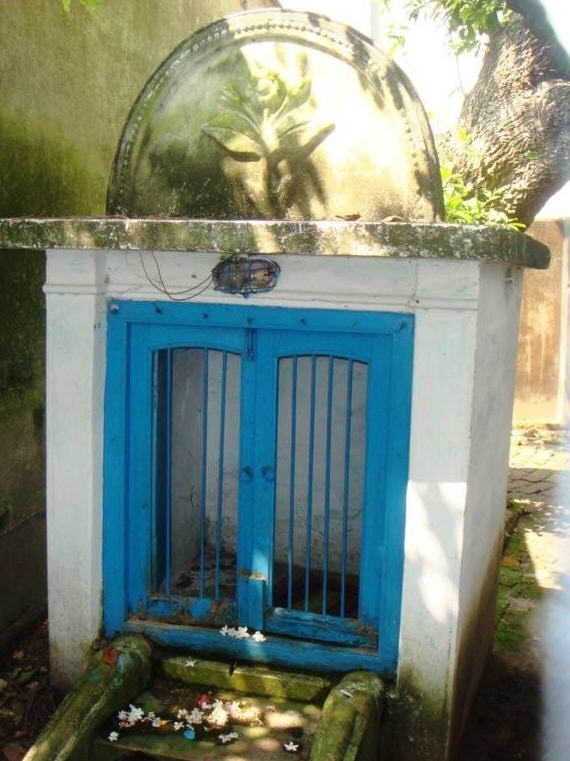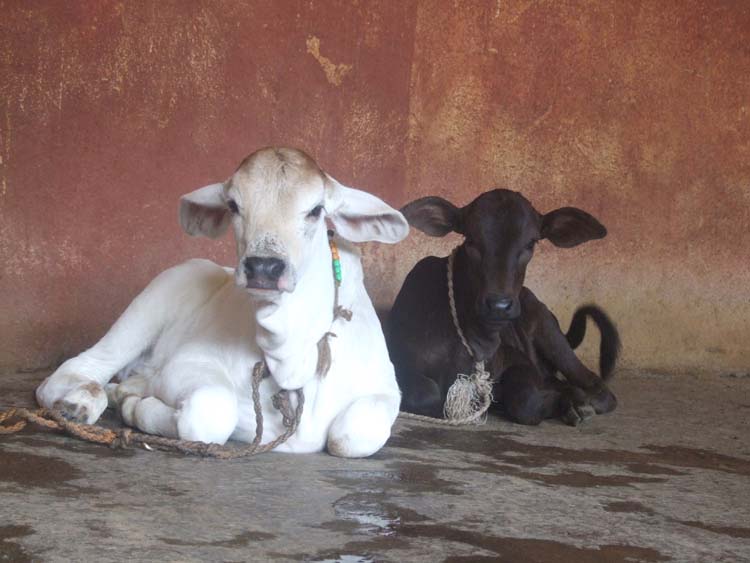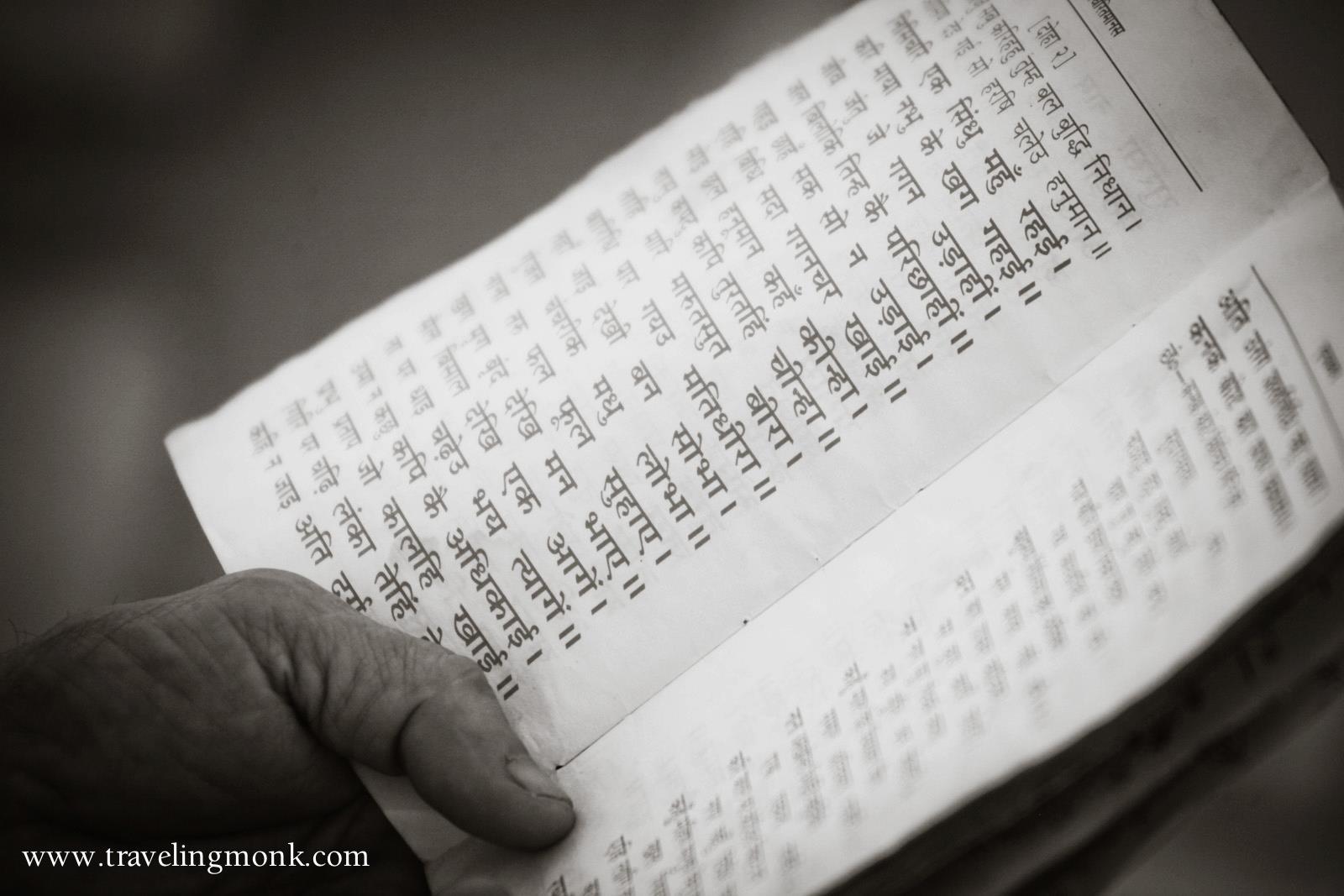
Babaji Maharaja always had great enthusiasm for kirtan and Vaishnava seva. Even when he was nearly 135 years old, he went on preaching the message of Shri Chaitanya throughout the world for the benefit of the fallen masses. In his old age, although he was almost paralyzed by infirmity, whenever it was time for kirtana he would still raise his arms in ecstasy. (In the image: Jagannath Dasa Babaji Maharaj, original photo).
Jagnnatha dasa Babaji was very austere; he never hesitated to fast without taking any water for three days at a stretch. He used to sit up the entire night chanting the Holy Name and at early dawn finish his ablutions. In the morning he took Prasada of curd and flat rice.
The following is a list of disciples of Siddha Jagnnatha dasa Babaji:
1. Biharidasa Babaji
2. Bhagavata dasa Babaji
3. Gaurahari dasa Babaji
4. Ramahari dasa Babaji
5. Ramadasa Babaji
6. Nityananda dasa Babaji, a resident of Varshana
7. Harekrishna dasa Babaji, a resident of Kadamakhandi
Jagannatha dasa Babaji lived in Vrindavana and performed his bhajan there for quite some time. Once he asked his servant Bihari dasa to locate a Deity to install there. Bihari dasa personally approached a weaver-caste Zamindar to help him in this regard. The Zamindar thus arranged to bring Deities of Gaura-Nitai from Dainhata and gave them to Bihari dasa. Nitai-Gaura looked so beautiful when They were installed that it appeared as if They were made of gold. On the occasion of the installation ceremony a sum of Rs. 3,000 was spent to feed the Vaishnavas of Suryakunda and Radhakunda.
One day a band of dacoits approached him with the motive of stealing the Deities which they thought were made of gold. He told them that he possessed nothing and they might look into the Temple for booty. The dacoits broke open the Temple door and quickly gathered up everything they could find, including the Deities. However, in rushing to make their escape they stumbled on the door step and dropped the Deities. Seeing that the sun had risen outside the dacoits left the Deities and rushed off with the rest of the booty. After this incident he asked Bihari dasa to arrange for the Deities to be cared for by someone else. Bihari dasa carried the Deities to Vrindavana where he handed Them over, along with Rs. 2,000, to Mother-Goswamini, a resident of Gayespur in the district of Maldaha. At present these Deities are residing at Dhopapada in Gopalbag and are known as "Sonara Gaura".
Sometime later he again asked Bihari dasa to locate another Deity for him. Bihari dasa found a Deity of the six-armed Lord Chaitanya which had been kept hidden in a bag of cattle-feed. This Deity belonged to Dinu Babaji, a Manipuri Vaishnava residing in Mathura near Radhakunda. Bihari dasa brought the Deity to Vrindavana where he cleansed and decorated Him, then carried the Deity, along with all items for worship, to Suryakunda.
For ten years thereafter Babaji Maharaja worshiped this Deity until one day he said, "Bihari, please put this Deity in the care of someone else in Vrindavana. I would like to go to Navadwipa. Let my body be offered at the lotus feet of Lord Gauranga." Bihari dasa brought the Deity to Vrindavana and after receiving a donation of Rs. 25 from Mother-Goswamini of Gayespur handed over the Deity as well as the money to Narottama dasaji, the head of the Gopalaguru Matha. At present this Deity is being served at the lane of Nidhuvana.
In 1880 Bhaktivinoda Thakura went to Vrindavana and saw him for the first time. While there, he received many instructions on Hari-bhakti from Jagannatha dasa. Some time later, Babaji Maharaja visited the Barddhaman district during the month of Phalguna. He stayed at a town called Amalajora. At that time, Bhaktivinoda Thakura again had the good fortune to take his darshana.
Seeing Bhaktivinoda Thakura's enthusiasm for preaching the Holy Name of Krishna, Babaji Maharaja was very happy. He stayed in Amalajora during Ekadashi, and that night there was kirtan and Hari-katha. Later, at Amalajora, Bhaktivinoda Thakura established his Prappana-ashrama.

Samadhi of Jagannatha Dasa Babaji Maharaja.
In 1893 Babaji Maharaja went from Koladwipa to Surabhi-kunja in Godrumadwipa. There he took his seat. His arrival in Surabhi-kunja was a wonderful event. Jagannatha dasa Babaji revealed many lost holy places in Mayapura, including the Yogapitha, Shrivasa Angana, and others. It is said that when he came upon the holy place of Mahaprabhu's birth he danced, although he was very old and walked with difficulty. For some time he remained in Nadia and performed his bhajan on the banks of the Ganges. His bhajan kutir and samadhi mandir are still there at present. He ordered Bhaktivinoda Thakura to build a hut so Devotees could stay near his bhajan kutir, and Bhaktivinoda did so.
When Bhaktisiddhanta Saraswati Thakura was twelve years old, he was an expert in the Jyoti-shastras explaining Vedic astrology. Hearing this, Babaji Maharaja one day called upon him to prepare the Vaishnava calendar in accordance with the proper siddhanta. He did so and Babaji Maharaja was very pleased. With this, the Navadwipa Panjika, the Vaishnava calendar recording the dates of the appearance and disappearance of important Vaishnava saints and the celebration of important festivals, began.
Babaji Maharaja always had great enthusiasm for kirtan and Vaishnava seva. Even when he was nearly 135 years old, he went on preaching the message of Shri Chaitanya throughout the world for the benefit of the fallen masses. In his old age, although he was almost paralyzed by infirmity, whenever it was time for kirtana he would still raise his arms in ecstasy.
Jagnnatha dasa Babaji was the vesa, or Babaji, guru of Bhagavata dasa Babaji Maharaja. Bhagavata dasa in turn gave the dress of a babaji to Gaura Kishora dasa Babaji. Jagnnatha dasa Babaji's servant's name was Bihari dasa. He was extremely strong and powerful. In his old age, Babaji Maharaja could not walk and Bihari dasa used to carry him in a basket on his shoulders. When he went to Calcutta, Babaji Maharaja would stay at the house of Bhaktivinoda Thakura on Manikatala Street. Bhaktivinoda was always very eager to invite him to his house for Prasada, but Babaji Maharaja was very renounced and would come only occasionally.
When he was in his old age, Babaji Maharaja was nearly blind. Many people would come to see him and to offer him donations for the service of Shri Krishna. His servant Bihari dasa would keep all these donations in a bag. One day, Babaji Maharaja said, "Bihari! How many rupees have I got?" Bihari dasa had put some rupees aside for some service he had planned to render Babaji Maharaja. When asked about how many rupees were on hand, Bihari placed some rupees in his hand and kept twelve rupees aside. Even though his eyesight was failing, however, Babaji Maharaja detected the discrepancy. "Bihari!," he said, "Why have you kept twelve rupees aside? Give me all the rupees!" Smiling at this fun, Bihari surrendered the remaining coins to his guru. At that time, Babaji Maharaja made his wishes known as to how the money should be spent. The total came to two hundred rupees. Babaji Maharaja ordered Bihari dasa to take the money at once and buy sweetballs, rasagulas, and feed all the cows in Navadwipa dhama.

"Bihari!," he said, "Why have you kept twelve rupees aside? Give me all the rupees!" Smiling at this fun, Bihari surrendered the remaining coins to his guru. At that time, Babaji Maharaja made his wishes known as to how the money should be spent. The total came to two hundred rupees. Babaji Maharaja ordered Bihari dasa to take the money at once and buy sweetballs, rasagulas, and feed all the cows in Navadwipa dhama. (In the image: Calves in Govardhan Eco Village, Wada, Maharashtra).
Once Babaji Maharaja was on the banks of the Ganges, living under a makeshift canvas tent. Nearby that place there lived a dog with five puppies. Whenever Babaji Maharaja would take Prasada, the dogs would come around and lick the food from his plate. When Bihari dasa caught hold of one of the dogs to drive it off, Babaji Maharaja told him: "Bihari! If you wish to drive these dogs off, you may take my plate away as well. I shall not eat today." When Bihari complained, "But guru Maharaja, these dogs are unclean!" Babaji Maharaja remarked, "No. These dogs are residents of the holy dhama. You may not abuse them."
Many people used to come and beg alms from Jagnnatha dasa Babaji. He did not want to give them alms, but told them to do service. One day a man named Shri Gaura Hari dasa came and asked Jagannatha dasa Babaji for alms, but Babaji Maharaja would give him nothing. When the man persisted for three days, fasting outside Babaji Maharaja's tent, Babaji Maharaja finally relented. He tore off a piece of his kaupina (undergarment) and gave it to Bihari dasa, his servant, with the instruction to present it to the beggar as alms, thereby informing the beggar that he must first learn to control his senses before taking up the profession of a saint.
One day Babaji Maharaja remarked about the professional readers of Shrimad-Bhagavatam, "This kind of professional Bhagavata kirtana is simply prostitution. Those who make their living by reading Shrimad-Bhagavatam are offenders to the Holy Name of Krishna. No one should listen to the kirtana and Bhagavatam readings that they produce. And one who listens to such offensive readings and thus commits offenses against the Holy Name of Krishna certainly goes to hell. Those who are involved in this professional reading should immediately give it up. Such a person should worship the residents of Vrindavana with great care and attention, considering himself most fallen, and thus pray for forgiveness."
In Navadwipa Jagannatha dasa Babaji preferred to live beneath a tree where now the bhajan kutir of Bihari dasa stands. Later Bihari dasa bought ten cottahs of land from Madhava Datta for Rs. 40. That plot had a huge ditch in it which Bihari filled up by carrying earth from the Ganges at night after Jagannatha dasa went to bed. Sometime later Kedaranatha Datta Bhaktivinoda arrived there and both he and Bihari dasa sought bhiksa from Nafar Pal Chowdhury of Mahesaganj and raised two shades. A while later, with the approval of Jagannatha dasa, Rajarshi Banamali Raya Bahadur built three small rooms and fenced them in with a surrounding wall. The aged Manamohini dasi, a resident of Kaigrama, arranged to dig a well. He lived here for 32 years until his disappearance at the age of 147 years.
Shrimad Bhaktivinoda Thakura remarked of Jagannatha dasa Babaji Maharaja that he was the topmost general among Gaudiya Vaishnavas.

"This kind of professional Bhagavata kirtana is simply prostitution. Those who make their living by reading Shrimad-Bhagavatam are offenders to the Holy Name of Krishna. No one should listen to the kirtana and Bhagavatam readings that they produce. And one who listens to such offensive readings and thus commits offenses against the Holy Name of Krishna certainly goes to hell. Those who are involved in this professional reading should immediately give it up. Such a person should worship the residents of Vrindavana with great care and attention, considering himself most fallen, and thus pray for forgiveness."